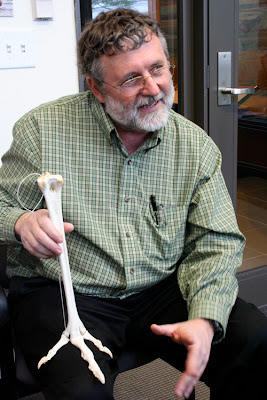
The mysterious writing on those stony pages consists of birdlike footprints or, as he called them, "hieroglyphs" or “footmarks.” Some of these curious stone footprints were turned up by the plow of a farmer named Pliny Moody as early as 1802. Other pages were discovered by men who split sandstone for sidewalks or gravestones.

Today scientists recognize these footprints as the fossilized tracks of dinosaurs who scampered along the muddy lakeshore 190 million years ago in what is now the Connecticut River Valley. In October I reported about a funky roadside attraction with fossils from the same geologic formation.

But the finest specimens are on public exhibition at the nearby Amherst Museum of Natural History. They were collected between 1835 and 1864 by Mr. Hitchcock, third president of Amherst College, and its first natural historian, in an era when natural history was a science in its infancy.
 The Museum’s Coordinator of Education, Steven Sauter, invited me and Jeanette to his office. He showed us the articulated footbones of an emu, about the same size and shape as those of the saurian track makers.
The Museum’s Coordinator of Education, Steven Sauter, invited me and Jeanette to his office. He showed us the articulated footbones of an emu, about the same size and shape as those of the saurian track makers. We went further into the basement of the museum, where the skeletons of a human and a gorilla hung silently side by side. Collections Manager Kate Wellspring showed us one of Hitchcock’s most extensive stony books. She carefully turned more than half a dozen sandstone pages, resting them on soft foam padding.
We went further into the basement of the museum, where the skeletons of a human and a gorilla hung silently side by side. Collections Manager Kate Wellspring showed us one of Hitchcock’s most extensive stony books. She carefully turned more than half a dozen sandstone pages, resting them on soft foam padding.
The track on the right is the actual footprint. On the left is the convex impression from the mud that filled in and covered over the print. The lakebed mud was so sensitive and delicate that raindrops and insect tracks are clearly visible.

My favorite fossil was from a squatting dinosaur that Hitchcock called an Anomoepus, basically a three-toed theropod about the size of a cassowary. The impression in the ancient mud shows the dinosaur resting on its keelbone (1) and haunches (2). Beside the right foot, the chestbone (3) also made a dent in the mud, accompanied by little lines that appear to be feathers—though Steve said that some scientists debate the feather interpretation.
I could easily imagine the little dinosaur resting for a moment at the edge of the lake to preen and nap.
Edward Hitchcock developed many of his ideas before the famous British naturalist Sir Richard Owen coined the word “dinosauria,” and before Darwin published The Origin of Species. Hitchcock's vision of nature was guided both by his religious faith and his keen empirical observation.
Richard Owen tried to convince Hitchcock that the creatures making the tracks were oversize lizards, but Hitchcock believed that they were some sort of giant birds. In the retrospect of current science, Hitchcock's interpretation was closer to the mark.

Museum docent and Amherst student Crystal Edwards showed me some of the more famous dinosaur skeletons. But the tracks are more vivid than the bones.
As I left the museum, I pondered Hitchcock's own words about his “stony volumes":
"Who would believe that such a register lay buried in the strata? To open the leaves, unroll the papyrus, has been an intensely interesting, though difficult work, having all the excitement and marvelous developments of romance. And yet the volume is only partially read. Many a new page I fancy will yet be opened, and many a new key obtained to the hieroglyphic record. I am thankful that I have been allowed to see so much by prying between the folded leaves.”







3 comments:
So very good to meet you. We enjoyed your visit very much and hope to show you and Jeanette more of the collection soon.
That was a very interesting virtual tour. The emu bones really made the walking of the dinosaurs a bit more intuitive.
The quote at the end was also nice. It sounds like Hitchcock found what he loved doing in life, and had a good handle on the scope of what he was doing.
By the way, you're getting a nice ratio of pictures-to-words in the blog...not just the books. :)
I wonder if those ARE feathers! I've always wondered if dinosaurs and like animals may have had some kind of down or fur-like substance to help regulate heat if they were in fact warm-blooded.
Post a Comment